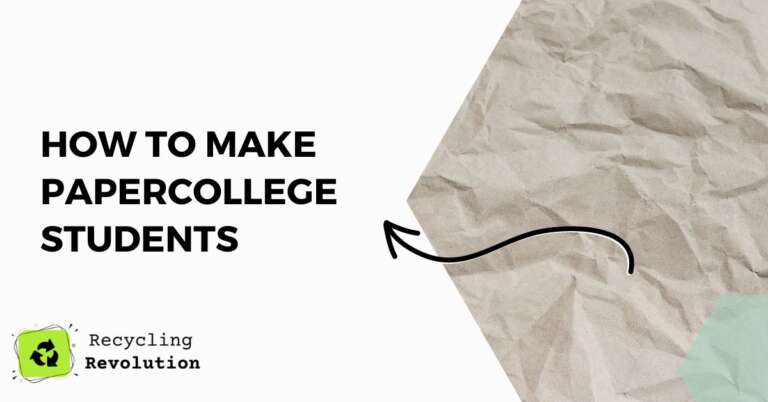Imagine creating your very own paper – customizing its texture, thickness, and color to suit your personal taste. Making your own paper is a fun and rewarding experience that allows you to express your creativity and ingenuity.
Curbing Paper Waste
Paper waste accounts for approximately 26% of total landfill mass in the U.S. (EPA, 2021). A single tree produces roughly 8,333 sheets of paper (Conservatree, 2021), and it takes 10-15 years for a tree to mature enough for paper production (FAO, 2023). Rapid consumption exacerbates deforestation concerns.
Not only will you produce a unique and beautiful little creation, but you’ll also contribute to a more sustainable world by recycling and repurposing materials such as reusing paper rather than throwing it away.
Gathering Materials: Building Your Papermaking Toolkit
To embark on your papermaking adventure, you’ll first need to gather some essential materials:
- Pulp: The raw material that forms the basis of your paper, which can be made from recycled paper, cotton, or plants like hemp or flax.
- Water: An essential component in the papermaking process, helping to bind the pulp fibers together.
- Mold and deckle: A screen-like frame that will shape and hold your paper as it dries.
- Optional additives: Dye, pressed flowers, or other embellishments to personalize your paper.
You can easily find these materials at local craft stores or even in your own home. For a more authentic experience, consider sourcing plant fibers or recycled materials from your local environment.
Types of Paper you can Use
| Type of Paper | Can be Recycled into New Paper? |
|---|---|
| Newspaper | Yes |
| Magazines | Yes |
| Office Paper | Yes |
| Corrugated Cardboard | Yes |
| Phone Books | Yes |
| Mixed Paper | Yes |
| Junk Mail | Yes |
| Paper Bags | Yes |
| Shredded Paper | Yes, but varies by facility |
| Paperboard | Yes |
| Hardcover Books | No, unless cover is removed |
| Tissue Paper | No, due to low fiber quality |
| Wax Coated Paper | No, due to wax coating |
| Paper Towels | No, often contaminated |
| Paper Cups | No, due to plastic lining |
| Carbon Paper | No, due to non-paper elements |
Preparing the Pulp: Crafting the Foundation of Your Paper
The type of pulp you use will determine the characteristics of your final product. Recycled paper creates a smooth and even texture, while plant fibers like cotton, hemp, or flax yield a more textured and robust finish.
Follow these steps to prepare your pulp:
- Soak your chosen material in water for several hours or overnight to soften the fibers.
- Blend the soaked material in a blender or food processor until it reaches a smooth, even consistency.
- Add any desired additives, such as dye for color or pressed flowers for a decorative touch.
Creating the Paper: Breathing Life into Your Pulp
Now comes the most magical part of the process – transforming your prepared pulp into a sheet of paper. Set up your mold and deckle by placing the screen on top of the frame. Then, follow these steps:
- Dip the mold and deckle into the pulp mixture, ensuring the entire screen is covered.
- Gently lift the mold and deckle out of the pulp, allowing the excess water to drain.
- Press the pulp into the mold by applying gentle, even pressure with your hands or a sponge.
To create different textures and thicknesses, experiment with the amount of pulp you use and the pressure you apply.
Drying and Finishing the Paper: Perfecting Your Masterpiece
Once you’ve created your paper, it’s time to let it dry and finalize its appearance:
- Carefully remove the paper from the mold and deckle by peeling it away from the screen.
- Transfer the paper to a flat, non-stick surface for drying.
- Speed up the drying process by using a hairdryer or placing the paper in the sun.
- Finish the paper by pressing it with weights or using a rolling pin to smooth out any imperfections.
Conclusion
Making your own paper is an enriching and fulfilling experience that allows you to explore your creativity, connect with nature, and produce a one-of-a-kind product.
As you hone your papermaking skills, seek out additional resources like books or online tutorials to further your knowledge and expand your artistic horizons. The world of papermaking is vast and exciting – so go ahead, dive in, and let your imagination run wild.
FAQs
What materials do you need to make paper?
To make paper, you’ll need pulp, water, a mold and deckle, and optional additives like dye or pressed flowers. These materials can be purchased online, at arts and crafts stores, or even created from recycled paper or plants.
What is the recipe to make paper?
The basic recipe to make paper includes preparing a pulp mixture from your chosen source material (recycled paper, cotton, or plants), soaking and blending the material, adding any desired additives, and then using a mold and deckle to shape and create the paper.
How is paper made in 5 steps?
- Prepare the pulp by soaking and blending your chosen source material.
- Add any desired additives, such as dye or pressed flowers, and mix well. 3. Set up your mold and deckle, and pour the pulp mixture into a shallow container with water.
- Dip the mold and deckle into the pulp mixture, lift it out, and gently shake it to disperse the fibers and drain excess water.
- Remove the paper from the mold and deckle, transfer it to a drying surface, and allow it to dry before finishing it with weights or a rolling pin.

